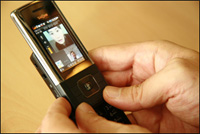Millions of mobile users access broadband services via HSPA
The number of mobile users with access to broadband services is increasing rapidly as operators upgrade their 3G networks with HSPA* technology and roll out an array of advanced 3G handsets. Operators in Asia, Europe, North America and Australia are all reporting a surge in uptake of HSPA devices capable of accessing the Internet and other multimedia services at broadband speeds, typically ranging from 500 kilobits per second to three megabits per second.
 In just seven months, KTF in Korea has acquired 2 million 3G customers, the vast majority of whom have HSPA devices. Telstra in Australia passed the one million milestone in just 10 months, and in the U.S. AT&T has more than five million 3G customers, the vast majority of whom have HSPA devices.
In just seven months, KTF in Korea has acquired 2 million 3G customers, the vast majority of whom have HSPA devices. Telstra in Australia passed the one million milestone in just 10 months, and in the U.S. AT&T has more than five million 3G customers, the vast majority of whom have HSPA devices.
There are already more than 120 different HSPA handsets available worldwide and that figure is set to rise dramatically as operators rollout new models for the peak Christmas season in Europe and the U.S. Vodafone, for example, has announced that it will add 10 new HSPA models to its handset range for Christmas 2007.
“Uptake of mobile broadband services is surging in many countries as consumers and business users see the benefit of having a high-speed connection available to them at all times,” said Rob Conway, Chief Executive Officer of the GSMA. “We are witnessing the creation of a virtuous circle in which mobile broadband will achieve further economies of scale, driving down the cost of HSPA equipment and enabling more and more people to enjoy easy access to mobile multimedia services.”
HSPA is also being widely used to provide broadband connections to computers and other devices, as well as mobile phones. Both TeliaSonera in Sweden and mobilkom austria, for example, have seen sales of HSPA modems for laptops surpass sales of any handset model. Telstra, mobilkom austria, and some other operators have recently upgraded their HSPA networks to enable users to upload, as well as download, data at high speeds, making it easy for them to post photos, videos, slide presentations and other large files to the Web or to friends and colleagues.
Telstra’s Next G network, for example, offers a peak uplink speed of 1.9 megabits per second. Telstra’s CEO, Sol Trujillo, said Australians have quickly realised the benefits of its high-speed HSPA Next G network, which was built and operational in a record 10 months servicing 98.8% of the population. “The speed, coverage and features of our world-class Next G™ network are second to none and have opened up new opportunities for our customers,” Mr. Trujillo said.
“I am proud to say that usage of mobile broadband is increasing rapidly in Austria and mobilkom austria, alone, has sold about 210,000 data cards and USB modems to date, which shows the considerable potential of mobile broadband”, said Boris Nemsic, CEO of the Telekom Austria Group and CEO of mobilkom austria.
“Consumers have embraced HSPA technology in the U.S. as AT&T has deployed its high-speed network and introduced new devices,” added Kris Rinne, Senior Vice President of Architecture and Planning at AT&T. “More than five million of our customers now have 3G devices, and are experiencing innovative new services, like VideoShare**, and connecting to the Internet, while on-the-go.”
“In Korea, our customers are using HSPA to watch films, download music, play games and access many other forms of entertainment,” said Won-Jin Park, Vice President of Business Development at KTF. “A wide range of broadband technologies are in use in Korea, but our customers are increasingly choosing HSPA because of its robust performance, its versatility, its affordability and global coverage and high level of support it enjoys from the international operator community.”
The rollout and usage of mobile broadband services will be one of main themes of the GSMA’s forthcoming Mobile Asia Congress in Macau. For example, the keynote session on the afternoon of November 13th, the first day of the Congress, is entitled ‘Building a Mobile Broadband Business’.
Please see for more HSPA statistics and analysis
Notes to Editors:
*HSPA – High Speed Packet Access, a software upgrade to W-CDMA 3G networks.
** VideoShare services allow one of the participants in a voice call to send live video of what they are looking at to the other participant.
About the GSMA:
The GSMA (The GSM Association) is the global trade association representing more than 700 GSM mobile phone operators across 218 countries and territories of the world. In addition, more than 200 manufacturers and suppliers support the Association’s initiatives as key partners.
For further information contact:
Mark Smith or David Pringle
Tel: +44 78 50 22 97 24 / +44 79 57 55 60 69
Email: [email protected]


